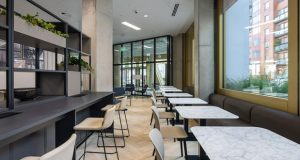Eve Fitzhenry, Marketing Manager at Boss Design, explains that today’s agile employees can best be supported by treating the workplace as a series of habitat
Before we discuss how wellbeing affects the workplace, I think it’s important to define the meaning of ‘wellbeing’. At its simplest level, wellbeing is ultimately about personal happiness – feeling good and working safely and healthily. In the workplace, it’s no longer just about the physical surroundings; wellbeing needs to take into account the emotional, social, financial and career aspects of individuals. All of these components are important, particularly since most of us spend a large portion of our lives at the office – which can have a major impact on our work-life balance and wellbeing. Quite simply, when we’re happy and healthy, we are more productive.
 However, statistics from the World Health Organisation show that an estimated 25 per cent of us are likely to suffer a mental health problem during our lifetimes. For those of us who don’t suffer in this way, we will most likely face times of great stress or uncertainty that will impact on our mental wellbeing. These difficulties are inevitably brought into the workplace too. Indeed, the European Agency for Safety and Health at Work estimates that as many as 60 per cent of lost working days annually are due to stress.
However, statistics from the World Health Organisation show that an estimated 25 per cent of us are likely to suffer a mental health problem during our lifetimes. For those of us who don’t suffer in this way, we will most likely face times of great stress or uncertainty that will impact on our mental wellbeing. These difficulties are inevitably brought into the workplace too. Indeed, the European Agency for Safety and Health at Work estimates that as many as 60 per cent of lost working days annually are due to stress.
The cost to a company with poor employee wellbeing can be significant. As well as the cost of lost productivity from sick days, there’s also added recruitment and training costs associated with absenteeism due to sickness and a high turnover of staff.
Well-designed and well-managed workplaces can play a beneficial role in promoting employee health and wellbeing. When our wellbeing is threatened in both physical and mental terms, absenteeism soars and we tend to find ourselves looking for another challenge. If businesses with healthy and happy workers enjoy high levels of staff morale and productivity, and, ultimately, enjoy healthy long-term profitability, it makes sense for the workplace to be an environment where we feel engaged and comfortable. This will not only foster our own individual health and wellbeing, it can have a significant impact on the company’s productivity and bottom line.
CREATING HABITATS
One of the first steps to achieving wellbeing in the workplace is to understand how we manage our work. Traditionally, the workplace has been designed for efficiency, often with a one-size-fits-all approach. However, when we are able to choose the right kind of habitat for the work we do, we have a greater sense of control that helps us feel more empowered, engaged and overall less stressed. This is based on the premise that we need to be able to easily switch our mode of focus – be it concentrating, learning, socialising, or collaborating – in order to stay fulfilled and productive.
By creating habitats and furnishing these with appropriate furniture settings to support us in all our activities, it will enhance our wellbeing and lead to a more streamlined and connected workplace. At Boss Design, we have identified six key habitats in the workplace. These consist of a ‘welcome’ habitat that can double up as a reception or business lounge, a ‘home’ habitat where we perform our work when in the office, and a ‘collaboration’ habitat that helps drive communication and flow of knowledge. A ‘flow’ habitat offers primary paths through the workplace that provide opportunities for planned and unplanned exchanges, while formal ‘meet’ habitats offer staged meeting environments. Finally, the ‘work café’ habitat is a key environment for socialising, refuelling and working in an open, engaging hub.
So how does the design of a habitat foster wellbeing?
 In a welcome habitat, for example, a foyer or reception area can be planned in such a way that it’s no longer confined to receiving visitors. Instead, it can perform as a casual business lounge and meeting area. By introducing a planned furniture setting, the welcome habitat can be exploited to maximise efficiency while ensuring that visitors’ waiting time is both comfortable and productive.
In a welcome habitat, for example, a foyer or reception area can be planned in such a way that it’s no longer confined to receiving visitors. Instead, it can perform as a casual business lounge and meeting area. By introducing a planned furniture setting, the welcome habitat can be exploited to maximise efficiency while ensuring that visitors’ waiting time is both comfortable and productive.
The use of high-backed meeting booths makes it possible to hold short meetings here, as opposed to bringing visitors into the body of the organisation and occupying meeting spaces that could be used for more formal and critical business activities. Equally, privacy booths and telephone pods are popular, offering visitors and employees the perfect place to make a private telephone call, or comfortably escape surrounding distractions to focus on work. Modular seating makes an effective setting as it offers more flexibility and helps the space take on a much softer and more intimate feel.




